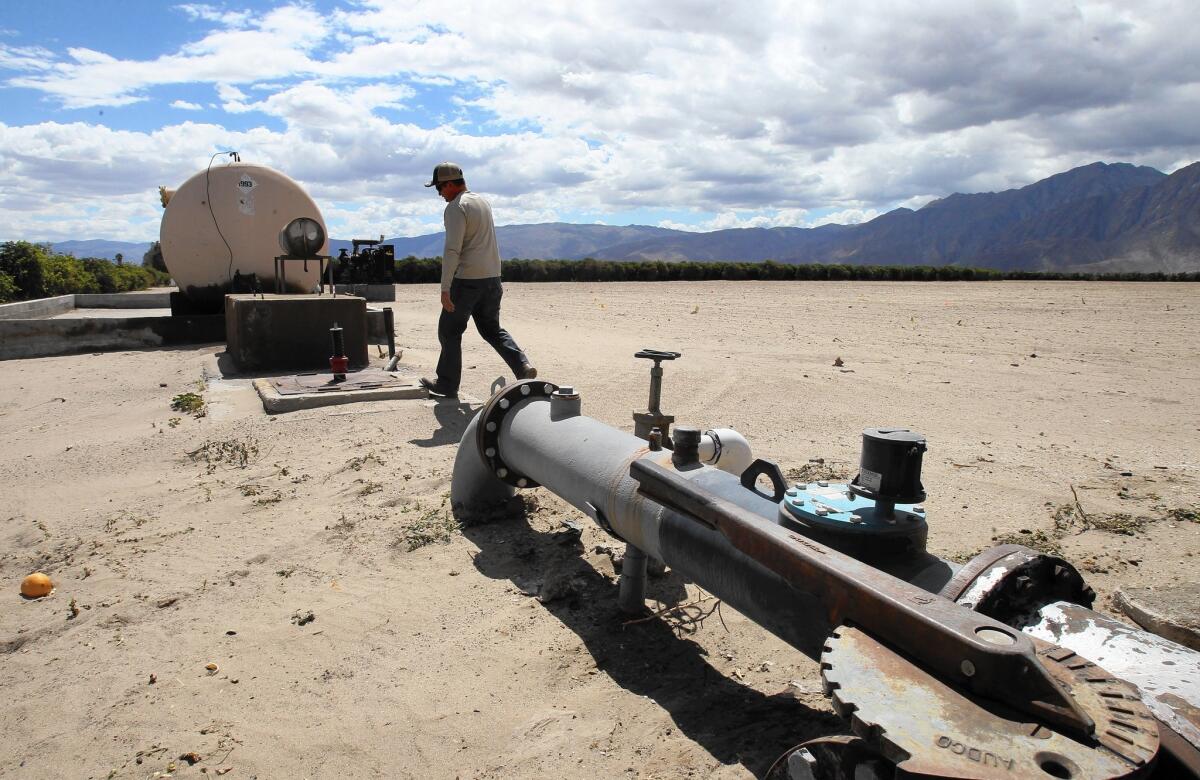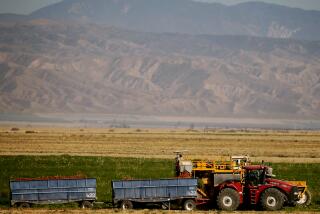Borrego Springs water crisis begins and ends with farming

A pipeline carries pumped water serving the Borrego Valley, where years of overdrafting has caused the water table to drop by as much as 119 feet in some areas, with a 26-foot decline in the last decade.
- Share via
The water crisis in Borrego Springs is as simple to understand as it will be difficult to solve.
At the crux is farming.
Citrus and palm ranches in northern Borrego Springs are sucking huge amounts of water from the underground lake beneath their land — far more than the state is likely to allow in the future.
The problem: Borrego Springs, home to about 3,000 permanent residents in the desert of northeast San Diego County, has no feasible way to import water. It completely relies on an underground aquifer that on average is replenished by nature each year to the tune of about 1.8 billion gallons.
But for decades, the amount of water that has been pumped out of the aquifer has been far greater — most recently, 6.1 billion gallons annually.

Less than one-third of the water pumped from the Borrego Springs aquifer supplies golf courses, resorts and residents. Farming uses 70% to 80%.
Years of overdrafting in the Borrego Valley have caused the water table to drop by as much as 119 feet in some areas, with a 26-foot decline in the last decade.
It’s not that Borrego Springs is running out of water. There are, in fact, three aquifers beneath the valley, one atop the other. But as the water table drops, it becomes more and more expensive to pump water out of the ground. If nothing is done, the cost of pumping the water will eventually exceed any economically feasible rationale to continue living there or working the land.
The city of Poway, home to nearly 50,000 people and hundreds of businesses, distributes a bit over 4 billion gallons of water to its users annually. Borrego pumps 50% more water, even though its population is far smaller.
In the northern part of Borrego Springs are farms growing roughly 2,000 acres of grapefruit, lemons, tangerines, tangelos and palm trees. Many have been in operation for more than half a century, and all have clear rights to the water beneath their land.
The farms use 70% to 80% of the water pumped out of the ground. The rest is consumed by five golf courses, resorts and residents, most of whom get their water from pumps controlled and distributed by the Borrego Water District.
It’s been known since the early 1980s that an overdraft problem exists. What has changed recently is a threat from the state, which last year enacted laws aimed at communities that rely on underground water.
There are more than 500 such sole-source basins in California, including 127 that have been determined to be of medium and high priority.
Borrego is placed in the medium category not because its problem isn’t immense, but because relatively few people are affected. More important, the Borrego Valley has been designated to be in “critical overdraft,” one of only 21 basins in the state (most are in the Central Valley) and the only one south of Los Angeles.
The state is demanding that the community — in this case, the Borrego Water District in conjunction with the County of San Diego — come up with a plan by 2020 to bring the basin into sustainability. If they don’t, the state will take over.
You know the saying, “I’m here from the government. I’m here to help you.” That’s usually not a good thing.
— Borrego Water District General Manager Jerry Rowling, speaking at a town hall gathering in late March
“You know the saying, ‘I’m here from the government. I’m here to help you.’ That’s usually not a good thing,” Borrego Water District General Manager Jerry Rowling told a town hall gathering in late March.
The plan then must be implemented and progress shown up until 2040, by which time the amount of water being pumped out of the ground can be no greater than what is naturally recharged.
At the town hall, Borrego Water District President Beth Hart was asked what the chances are that farmers would cut back usage to anywhere close to the levels that will be needed.
“I wouldn’t have had a good answer three years ago,” Hart said.
That was when the state Department of Water Resources drew together the largest pumpers in the basin — farm owners, golf course heads, state park representatives, business owners and residents — a group that eventually called itself the Borrego Water Coalition.
Hart said initially the farmers’ positions were intransigent.
“What we initially heard was that no one was going to do anything except sue somebody else,” she said. “But what we found after talking with them is businesspeople — businesspeople [who want to either] continue their business or make themselves an exit strategy that would work.”
She said the farmers can see the reality. Because of the new water sustainability rules, they will either have to leave the valley or find some way to sell their crops at high enough prices to cover the costs.
The district has already been approached by nonprofit land-acquisition and environmental groups that are waiting to see whether an opportunity arises, Hart said.
Borrego Springs is surrounded by the Anza-Borrego Desert State Park. The Anza-Borrego Foundation, which for decades has been purchasing land to add to what is by far the state’s largest park, is one of those groups.
“We certainly know how to do it,” said Paige Rogowski, the foundation’s executive director. “This would be new territory for us specifically with agriculture land. But if we can work it out, we’re glad to help.”
Wealthy part-time residents with vacation homes in the area and their own foundations have also expressed willingness to help with the problem, Hart said.
One idea in its infancy could involve UC Irvine, which has a desert research station in the area.
“They are interested in taking farmland that is fallowed and seeing what it would take to restore it,” Hart said recently.
J. Harry Jones writes for the San Diego Union-Tribune.
ALSO
El Niño rains added fuel to California’s upcoming fire season, experts say
In landmark step, feds will regulate e-cigarettes; sales to minors banned
San Andreas fault ‘locked, loaded and ready to roll’ with big earthquake, expert says
More to Read
Sign up for Essential California
The most important California stories and recommendations in your inbox every morning.
You may occasionally receive promotional content from the Los Angeles Times.













